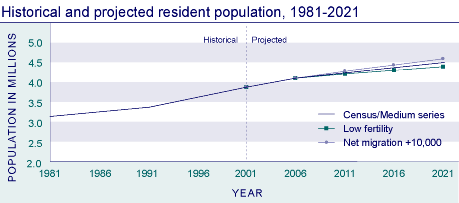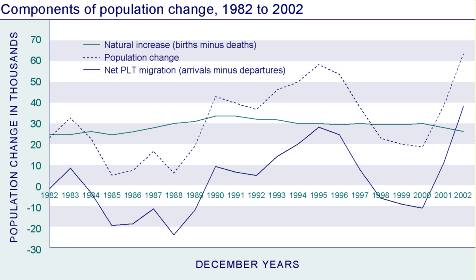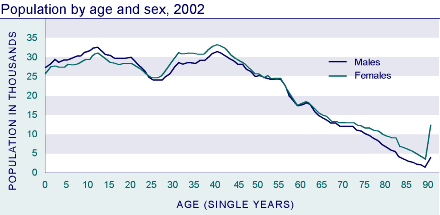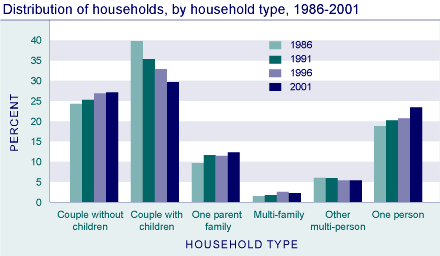People
The Social Report monitors outcomes for the New Zealand population. This section provides background information on who those people are, and provides a context for the indicators that follow.
Population size and growth
New Zealand's estimated resident population was 3.98 million at the end of December 2002 and reached four million on 24 April 2003.
During the 2002 year, the population grew by 63,400 or 1.6 percent, a rate of growth that was higher than the average for the decade and comparable to a previous peak in 1995.
Under medium population projection assumptions, the population is expected to grow by an average of 1.2 percent per year up to 2006, reflecting significant net migration gains during this period. Assuming net migration of 5,000 people per year after that, the growth rate is then expected to slow gradually to 0.6 percent per year during the 2010s. Such a growth rate would add around half a million people to the population by 2021.
Figure P1

Source: Statistics New
Zealand Note: All three projections assume medium mortality. The
medium projection series assumes medium fertility and a long-term
annual net migration gain of 5,000
Components of population change
Natural increase (births minus deaths) has been the main component of population growth over time.
Births exceeded deaths by 26,000 in the December 2002 year. However, the contribution of natural increase is slowly declining as the population ages and fertility declines.
Figure P2

Source: Statistics New Zealand
The number of people coming to live in New Zealand exceeded those leaving the country to live elsewhere by 38,200 during the December 2002 year. This year was striking in that net gain from permanent and long-term (PLT) migration accounted for 60 percent of the growth in population. This was driven by a sharp drop in the number of arrivals in 2001 and 2002, and a rise in the number of departures.
The contribution of net migration to population change includes both changes in the numbers of New Zealand nationals leaving or returning to New Zealand as well as changes in the numbers of migrants coming from overseas. More new migrants are coming from Asian countries. Auckland is the destination of the largest group of migrants.
Fertility
Fertility rates for the year 2002 suggest New Zealand women average 1.9 births per woman.
This is about 10 percent below the level (2.10 births per woman) required for a population to replace itself without migration. The New Zealand total fertility rate is lower than that of the United States (2.12) but higher than that of Australia (1.73) and about 10 percent higher than the fertility rate for Canada, England, Wales, and Sweden. The comparatively high rate in New Zealand reflects the higher fertility rates of Māori (2.47 births per woman in 2002) and Pacific women (2.55), who make up a fifth (22 percent) of women in the reproductive ages.
Since 1992, the median age of women giving birth has risen from 28 to 30 years (half were older, half were younger). Māori women tend to have their children at a younger age. The median age of Māori women giving birth increased from 25 years in 1996 to 26 years in 2002.
New Zealand has a relatively high teenage fertility rate by international standards. Between 1996 and 2002, the birth rate for young adolescents (under 18 years) fell from 18.0 to 13.6 per 1,000 females aged 15-17 years. Māori and Pacific females under 18 years have relatively high fertility rates but these also declined between 1996 and 2002 (Māori: from 48.3 to 35.3 per 1,000; Pacific: from 28.2 to 21.7 per 1,000).
Distribution of the population
Over three quarters (76 percent) of the population live in the North Island, and nearly a third of that amount (32 percent) in the Auckland region.
Reflecting the impact of migration, growth in the population of the Auckland region accounted for two-thirds (68 percent) of the total population growth over the period between the 1996 and 2001 censuses.
The Māori population is heavily concentrated in the North Island (88 percent), but only 24 percent of Māori live in the Auckland region.
The New Zealand population is highly urbanised. At the 2001 census, 86 percent of the population were living in an urban area. This includes 71 percent living in main urban areas (population 30,000 or more), six percent living in secondary urban areas (10,000-30,000) and eight percent living in minor urban areas (1,000-10,000).
There are marked ethnic differences in urbanisation, with the vast majority of Pacific, Asian and Other ethnic groups living in main urban areas and very few in rural areas.
Table P1 Urban and rural residence (%), by ethnic group, 2001
| European | Māori | Pacific Peoples |
Asian | Other | Total | |
|---|---|---|---|---|---|---|
| Main urban area (30,000+) | 69 | 64 | 92 | 94 | 92 | 71 |
| Secondary urban area (10,000-29,999) | 7 | 7 | 3 | 2 | 2 | 6 |
| Minor urban area (1,000-9,999) | 9 | 13 | 2 | 2 | 2 | 8 |
| Total urban | 84 | 84 | 98 | 98 | 97 | 86 |
| Rural | 16 | 16 | 2 | 2 | 3 | 14 |
| Total | 100 | 100 | 100 | 100 | 100 | 100 |
| Source: Statistics New Zealand, 2001 census, Ethnic Groups, Table 5a | ||||||
Ethnic composition of the population
The New Zealand population is becoming more ethnically diverse.
While the European ethnic group category still has the largest share (80 percent), the number of people identifying as European increased by only three percent between 1991 and 2001. Over the same period, the number who identified as Māori increased by 21 percent, the Pacific peoples ethnic group increased by 39 percent, and the number of Asian people increased by 138 percent.
Table P2 Ethnic distribution of the population, 1991, 2001
| Ethnic group | 1991 | % | 2001 | % |
|---|---|---|---|---|
| European | 2,783,025 | 83.2 | 2,868,009 | 80.0 |
| Māori | 434,847 | 13.0 | 526,281 | 14.7 |
| Pacific peoples | 167,070 | 5.0 | 231,801 | 6.5 |
| Asian | 99,756 | 3.0 | 237,459 | 6.6 |
| Other | 6,693 | 0.2 | 24,924 | 0.7 |
| Total with ethnicity specified | 3,345,813 | 104.3 | 3,586,731 | 108.5 |
| Source:
Statistics New Zealand, 2001 census, National Summary, Table 8 Note: The ethnic data in this table allows up to three responses per person. Where a person reported more than one ethnic group, they have been counted in each applicable group. Totals therefore do not add up to 100 percent |
||||
In 2001, Māori made up 14.7 percent of the usually resident population compared with 13 percent in 1991. More people said they belonged to an Asian ethnic group than a Pacific peoples ethnic group in 2001 (6.6 percent, compared with 6.5 percent for Pacific peoples). Ethnic groups other than European, Māori, Asian or Pacific peoples made up 0.7 percent of the population in 2001. By 2021, the Māori share of the population is projected to be 17 percent, Pacific peoples share nine percent, and the Asian share 13 percent.
Ethnic diversity varies by age: among those under 25 years in 2001, 22 percent were Māori, 10 percent were Pacific peoples, eight percent Asian and one percent other ethnic groups. Among those aged 65 and over, Māori made up four percent, Pacific people and Asians each made up two percent, and other ethnic groups 0.2 percent.
The number of people with multiple ethnic identities is increasing. In 2001, 91 percent of the population identified with one ethnic group, down from 95 percent in 1991. Having multiple ethnic identities is particularly common among Māori. Of those who said they belong to the Māori ethnic group in 2001, 44 percent identified with at least one other ethnic group. Younger people are far more likely to be identified with more than one ethnic group than older people. Birth registration data for 2001 shows that about one in five babies was identified with more than one ethnic group, compared to one in 10 mothers.4
Ethnicity is a difficult concept to measure. Different data sources sometimes define ethnicity in different ways. The figures for the ethnic distribution used in this section of the social report are based on the number of people identifying with each ethnicity. Because people can identify with more than one ethnicity, the total number may be greater than the size of the population. Elsewhere in the social report, the approach to measuring ethnicity varies with the data source used.
Age and sex structure of the population
Just over half the New Zealand population (51 percent) is female.
Males outnumber females among children and youth, but females are predominant among adults, particularly from the late twenties to the mid-forties, and from the late fifties onwards. More males are born than females, but male youth have higher mortality rates than females. The imbalance in the middle years is an outcome of sex differences in net migration (there were more males than females in the net migration loss in the three years before the 2001 census, and more females than males in the net migration gain of the previous five years). At older ages it reflects the higher mortality rates of males.
Figure P3

Source: Statistics New Zealand
The New Zealand population is ageing: the median age of the population is currently 35 years and is expected to rise to 38 years by 2012, and to 40 years by 2023.
The proportion of the population under 15 years of age has declined from 26 percent in 1982 to 22 percent in 2002 and is expected to fall to 19 percent by 2012. The population aged 65 and over has increased from 10 percent of the total population in 1982, to 12 percent in 2002 and will reach 14 percent by 2012.
Population ageing within the working age group will be partly offset over the next decade by the entry of the 'baby blip' group - the relatively large generation of babies born around 1990 - into the young adult age groups. By 2012, the 15-24 age group is expected to be 16 percent larger than it was in 2002. Over the same period, there will be a slight decline in the number of people aged 25-44, and an increase of 26 percent in the population aged 45-64 years. By 2012, 45-64 year olds will make up 39 percent of the working age population, compared with 34 percent in 2002.
Age structure varies widely by ethnic group. In 2001, the European ethnic group population was the oldest, with a median age of 37 years, followed by Asians (28 years), other ethnic groups (26 years), Māori (22 years) and Pacific peoples (21 years). By 2021, half of all Māori will be older than 27 years, and half of all Pacific peoples older than 24 years.
Households
There were 1.3 million households in New Zealand in 2001, an increase of 23 percent over the number recorded in 1986.
New Zealanders have a diverse range of living arrangements. A household may contain a single person living alone, parents with children, a group of individuals flatting together, or several families.
Twenty-seven percent of households contained couples without children in 2001; 30 percent contained two parent families; 12 percent were one parent family households; two percent contained more than one family; five percent comprised a group of individuals; and 23 percent were one person households.
Figure P4

Source: Statistics New Zealand
Couple-only and one person households are the fastest growing household types and are projected to increase the most over the next 15 years. Population ageing is the major factor behind both of these changes. But declining fertility and the closing gap between male and female life expectancy are also contributing to the rising number of couples without children, while delayed marriage, divorce and changing lifestyle preferences are contributing to the growing number of one-person households.
Families with children
In 2001, there were 591,712 families with children living within New Zealand households, 81 percent of which contained dependent children (aged under 18 years and not in full-time employment).
Of the 479,334 families with dependent children, 71 percent had two parents (339,159 families) and 29 percent had one parent (140,175 families). Most one parent families were headed by a sole mother (83 percent, or 117,015), while the remaining 17 percent (23,160) were headed by a sole father.
The number of families with dependent children increased by 6.6 percent in the decade to 2001, compared with just 1.5 percent in the previous decade. The most significant change in families in the past two decades has been the shift from two parent to one parent families. This was more pronounced in the 1980s, when the share of one parent families increased from 14 to 24 percent, than in the 1990s, when it rose to 29 percent.
New Zealand has a relatively high proportion of families with children under 18 headed by sole parents, second only to the United States (31 percent in 2001) and higher than the United Kingdom (22 percent), Australia and Canada (both 21 percent). One parent families are expected to continue to increase, but at a slower rate. For some of these families there will be parents living in another household who are actively involved in the care and upbringing of the children.
Another change is the decline in marriage among couples with dependent children. In 2001, 11 percent of families with dependent children were headed by a couple who were cohabiting but not legally married, an increase from three percent in 1981.
Table P3 Families with dependent children, by family type and marital status, 1981, 1991, 2001
| 1981 | 1991 | 2001 | |
|---|---|---|---|
% |
% |
% |
|
Two parent family |
86 | 76 | 71 |
| Married | 83 | 70 | 59 |
| Cohabiting | 3 | 5 | 11 |
| Same-sex | n.a. | n.a. | 0.2 |
One parent family |
14 | 24 | 29 |
| Sole mother | 12 | 20 | 24 |
| Sole father | 2 | 4 | 5 |
Total |
100 | 100 | 100 |
| Source: Statistics New Zealand, census | |||
Parents of dependent children in 2001 were older, on average, than their counterparts in 1986. Over that period, the median age of parents living with dependent children increased from 38 to 40 years for fathers, and from 35 to 38 years for mothers. The median age of sole mothers increased from 34 to 36 years.
